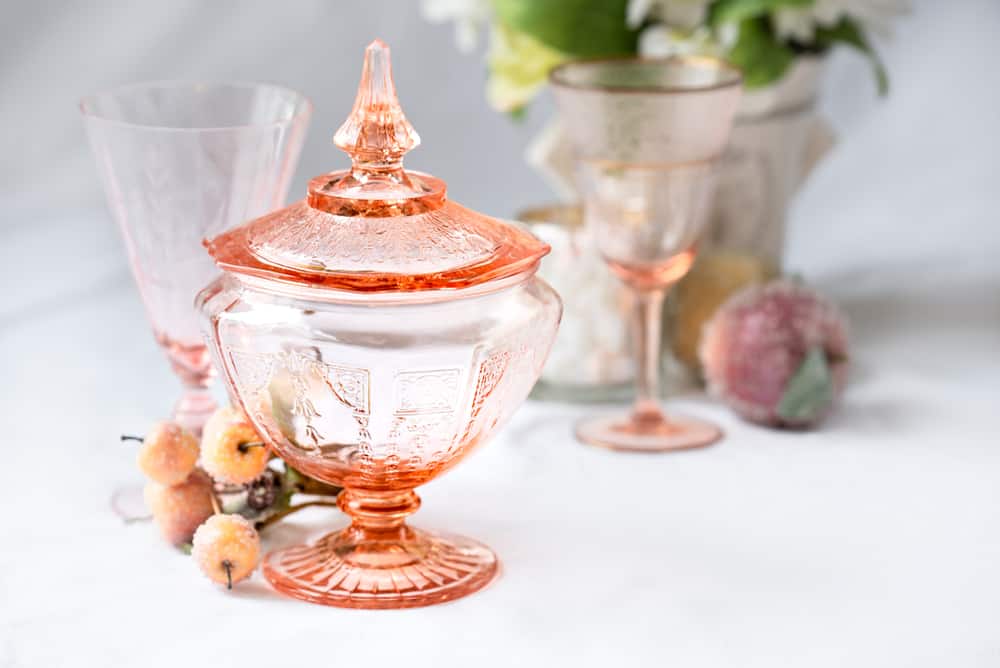Pink Depression Glass has become a collector’s favorite when it comes to antique glassware. Found in grandparent’s collections, antique stores, online, and even in pawn shops, Pink Depression Glass is a rare find leftover from the great depression. Ranging from several dollars to several hundred, this heirloom glassware is highly sought after.
Table of Contents
Brief history
When the United States stock market came crashing down in 1929, black Tuesday was considered the start of today, known as the great depression. The most significant downturn in financial history in the US, its impact on households across the nation lasted for over a decade.
Once well-off families had to abandon their luxurious purchases and begin making more economical and fiscally responsible decisions in food and automobiles. Even though many businesses were put off the market during this financial downturn, several creative glass companies managed to survive and thrive, creating affordable and easily marketed glassware for distribution.
Known as depression glass, this inexpensive, mass-produced household glassware had excellent manufacturing run from the 1920s through the 1950s. They rose to prominence during the 1930s as a cheap alternative to expensive dining ware. A relic of the depression, this glass is highly prized today by collectors.
How to identify antique pink depression glass
Made with bold, bright colors and inlaid with various intricate patterns, depression glass has a few defining characteristics that make it easy to identify with the novice eye. Distinguishing depression glass from counterfeits or reproductions can seem like quite a daunting task. However, noting tiny bubbles within the glassware frame or small lines on each piece’s base can signify a genuine depression glass.
color
What are the first defining characteristics of a depression glass is its color. Usually, amber, green, blue, tangerine, yellow, or pink depression glass comprises brightly colored cheap glass. Initially designed to stand out and be bold, these pieces will instantly grab any collector’s attention.
thin material
Often patterned with intricate designs and geometric shapes, depression glass feels and looks thin. Because of the depression, production costs were at an all-time low, meaning the corners were cut, and the most inexpensive products were developed. If collectors look at the glass’s edge, the material should feel delicate and relatively thin.
patterns
When identifying specific pieces of Pink Depression Glass, you should look for patterns. For instance, the Macbeth has scrolls and swags bunched together that may resemble flowers, while Princess patterns have a twist of circles and beads. Paying close attention to the specific ways can help you differentiate between originals and reproductions.
chipped
Often, genuine pieces of depression glass art are chipped. This is due to the low production cost and thickness of the glass.
According to the web, or reference books available in both libraries and online, there are 92 recorded patterns of depression glass. While they’re often aren’t stamps or logos to identify the maker of the piece, these guide books or websites can be a reference. Determine the trademark feature or characteristic of the work in question and see if it can match up to the concerns available.
Pink Depression Glass Patterns
There are a variety of popular patterns distinct to pink depression glass that help identify them and set them apart from other glassware that can be found on Etsy both in value and aesthetic.
American Sweetheart Depression Pattern Glass
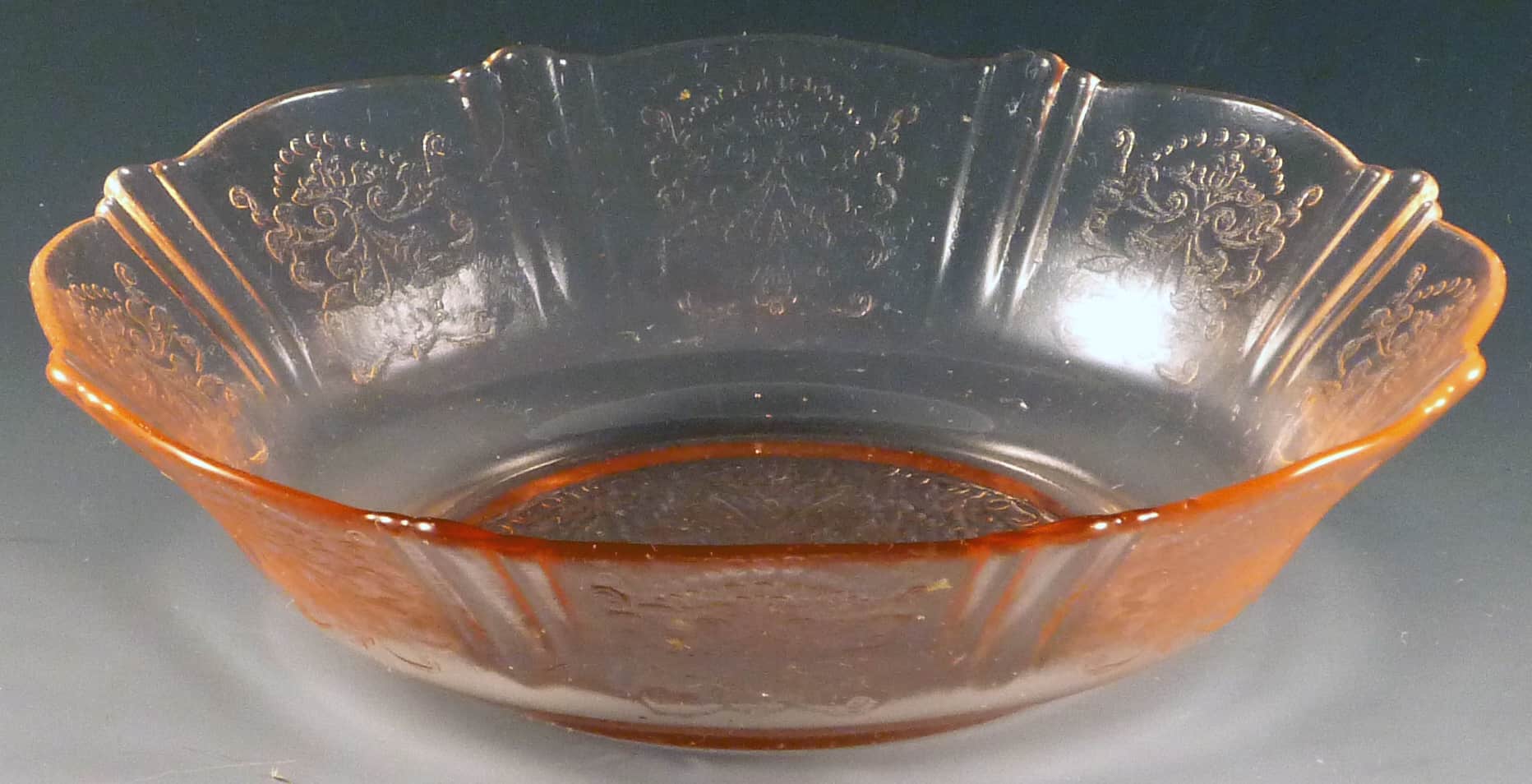
Known as monax, this pattern usually consisted of opaque white glass. Common to pink, shades of deep red and blue, the rarity of these American Sweetheart pieces makes them invaluable. An angelic, ethereal patterned glass, the American Sweetheart is set apart by its scrolls and swags motif inside ovals and wide rims.
Holiday Depression Glass Pattern
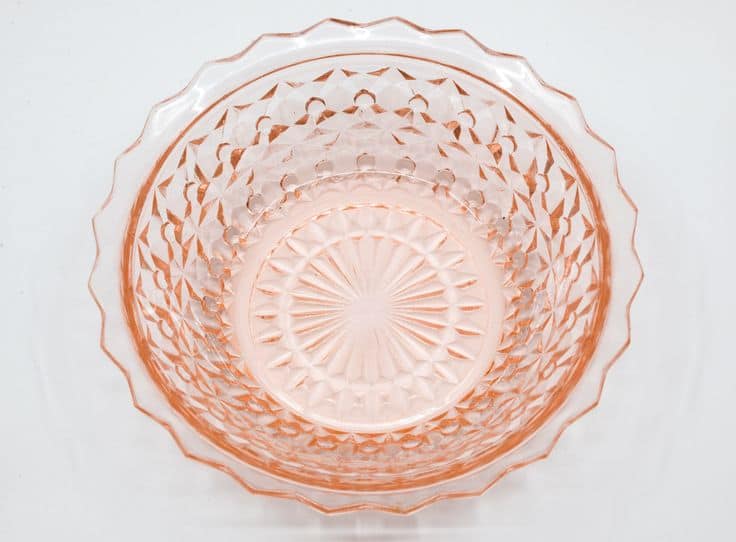
Also referred to as “buttons and bows,” this pink glass was produced towards the tail end of the depression glass is run. Most common in colors of pink but occasionally iridescent or clear, this depression-era glass pattern is a sight to behold. Its convex Rhomboid digit pattern surrounding the entire piece makes Holiday Glass easy to spot.
Mayfair Depression Glass Patterns
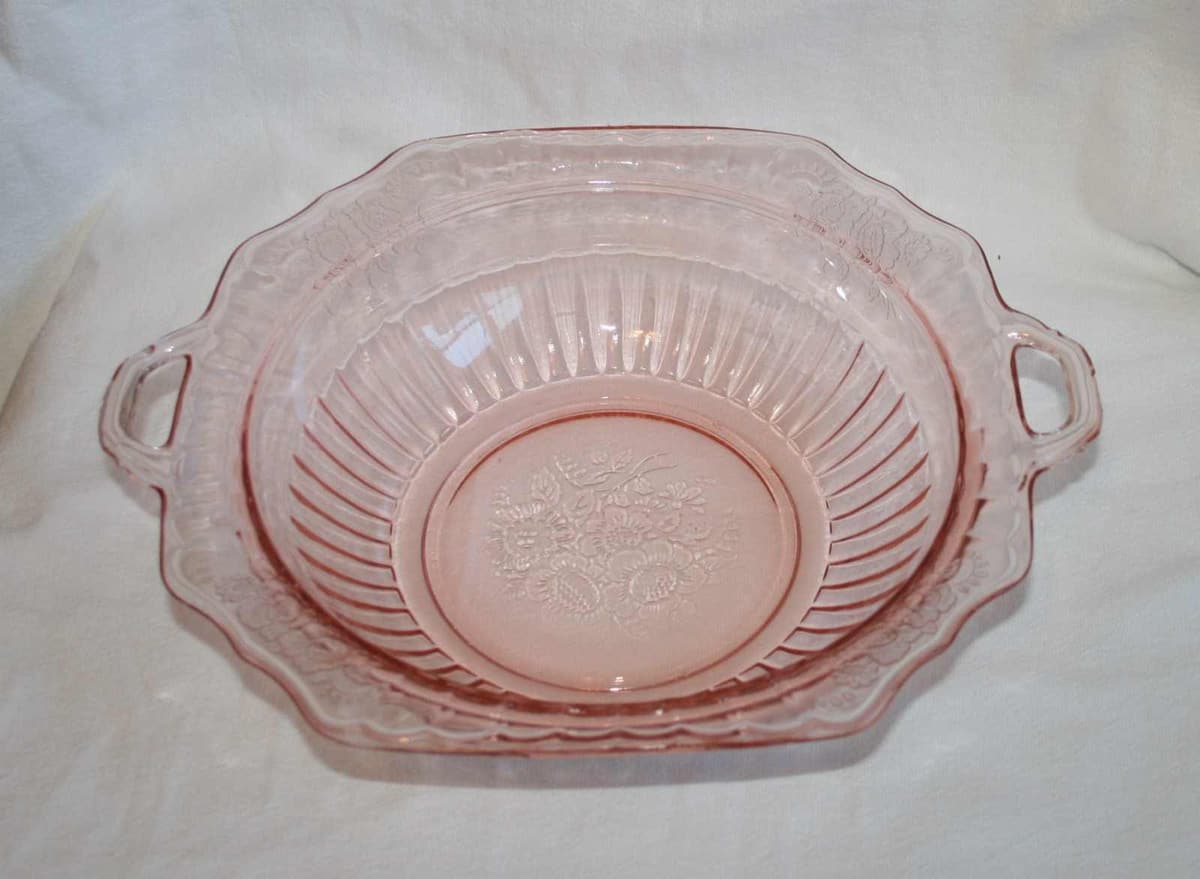
Also referred to as open Rose, these patterns are often found in pink and, on occasion, icy blue. Common to shot glasses and cookie jars, reproductions often fail to match the distinct shade of pink or blue common in the originals. With cut corners, scalloped edges, and a close to octagon shape pattern, the Mayfair has paneled corners, and an opening rose pattern etched into its glass.
Patrician Depression Glass Pattern
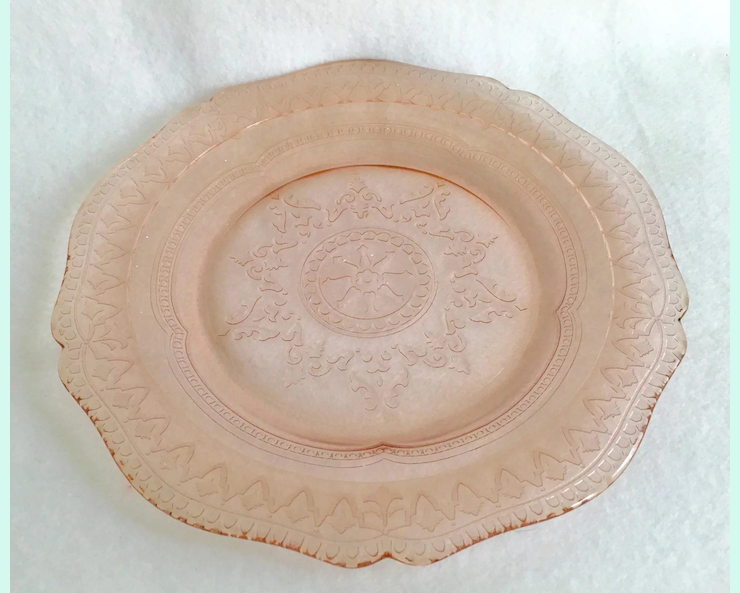
Referred to by collectors and dealers as “Spoke,” this pattern often came in green and amber, but occasionally, crystal or pink pieces can be found.
These pieces commonly have some roughness on the inner rim; the Patrician pattern is marked by a central Spoke surrounded by lacy patterns and edges with a triple design.
Princess Depression Glass Pattern
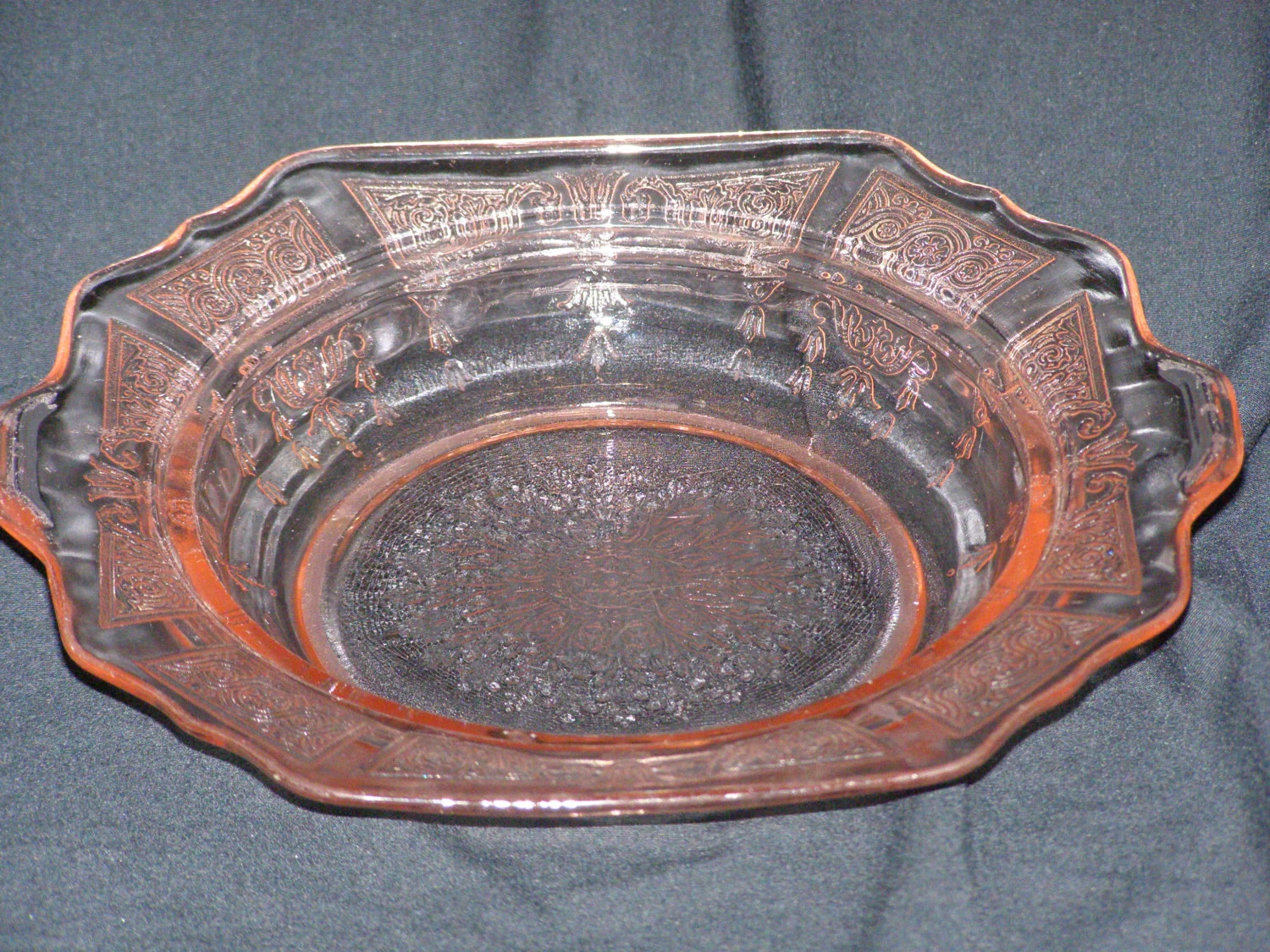
The most common colors Princess comes in are Pink and Green, but occasionally yellow or a sky blue. Square-shaped plates, lids, and bowls with removed corners and scalloped edges are critical features of the Princess Depression Glass Pattern. Identifiable by shallow corner scallops, beads at the end of scrollwork, and a twist-like pattern of circles.
Cherry Blossom Depression Glass Pattern
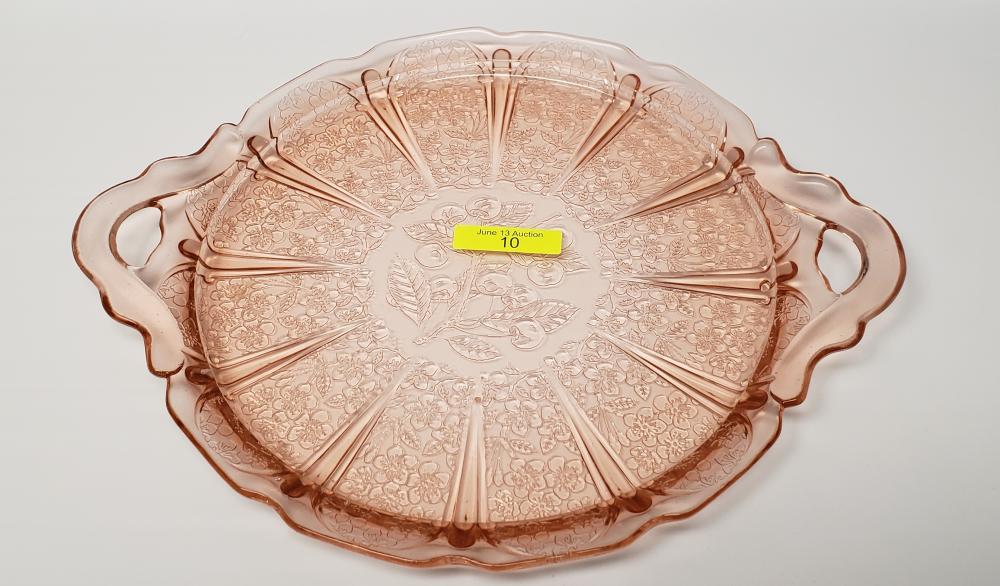
The most reproduced pattern of Depression Glass, this type of glass was most often found in Pink and Green. Cherry Blossom is identifiable through its roughly shaped leaves, and cherries etched into the glass, often having sawtooth edges and looking veiny.
Doric Depression Glass Pattern
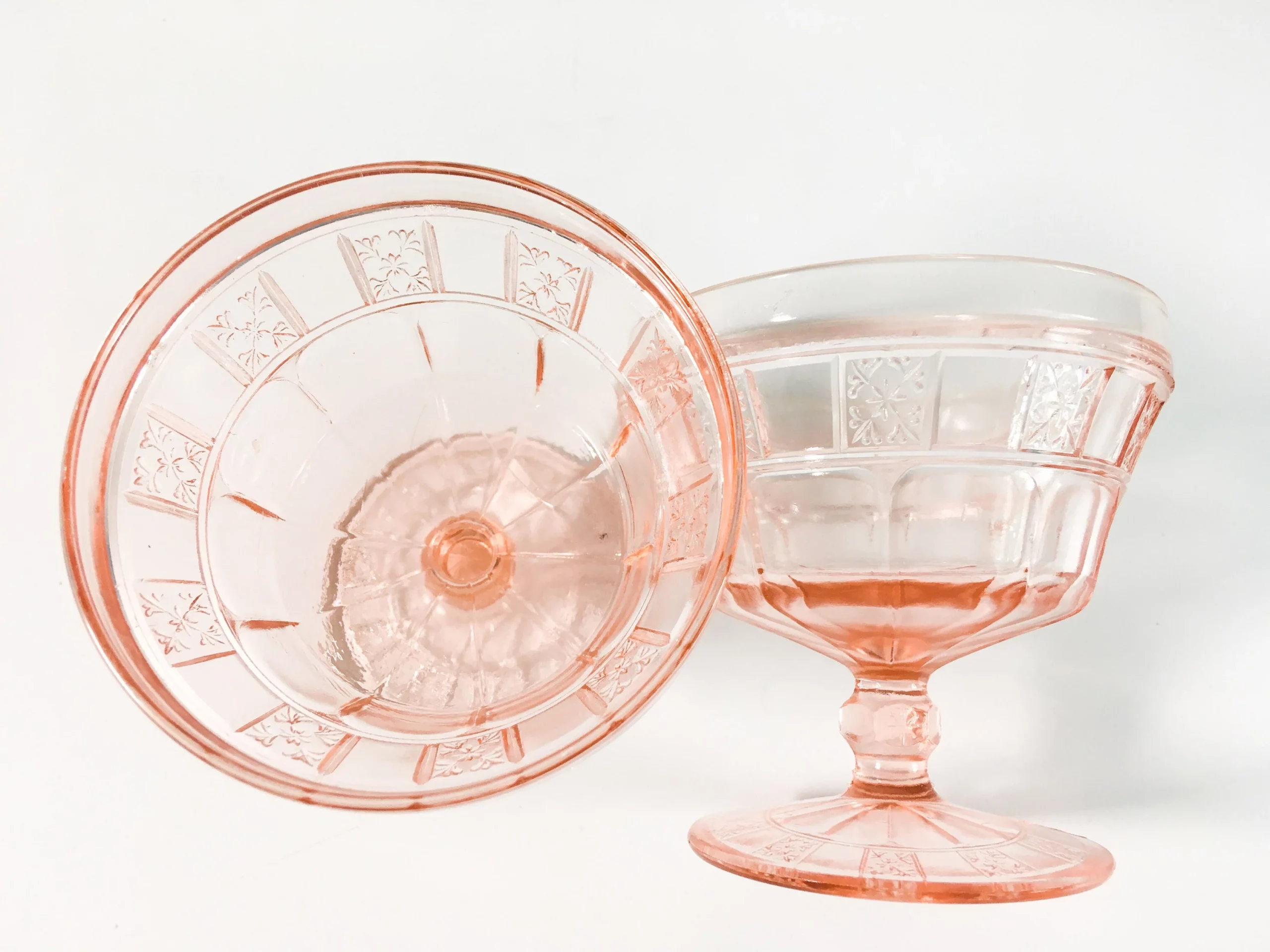
Doric or Pansy, this pattern was commonly found in children’s dish sets. Though it came in various colors, Doric can often be found in Pink or Green. Easily distinguishable by squares with pansy-like flowers that alternate with squares bearing a simple geometric design, Doric or Pants is a beautiful addition to any collection.
How to appraise an antique pink depression glass?
Because of its rarity and sought-after status among collectors and enthusiasts alike, the antique pink depression glass is a hot commodity. Though this glass can often be found in an antique store, the value can range drastically. Spending the gamut from several dollars to well over a hundred, it can be not very clear for amateurs to determine the worth of their piece.
identify the pattern
The first step any owner or potential owner of pink depression glass should do when attempting to determine the item’s worth is to identify the pattern. Depression glass has a unique design that sets it apart from its modern-day reproductions or phonies.
Most pieces of depression glass don’t always come with a stamp or trademark, but the patterns are always unique. Distinguishing features include geometric patterns, unusual shapes, detail etched into the glass, and opaque or opalescent trim.
Pieces common in antique stores or collections include plates, bowls, teacups, saucers, pitchers of varying sizes, trees, cake plates, and glasses. On occasion, pieces that are rare and difficult to identify appear. These archaic collector items are highly sought after. If a piece is difficult to identify, you should refer to the several available online sources to reference against.
condition
When appraising a piece of depression glass, the condition is one of the foremost aspects in determining its worth. Heirloom pieces of glass being sold with a price should be assessed before being purchased or placed on the market.
Oddly enough, some of the original depression glass came with flaws and structural deformity. Rough spots, tiny lines notice, straw marks, and bubbles are included in the faults common to mass-produced depression glass. These flaws will not affect the appraisal as they denote mint condition. However, it should be noted that these floors do not include cracks or severe structural damage that characterizes flaws in the piece’s integrity.
Minor condition issues include scratches, slight nicks, or tiny chips. This is indicative of use but not abuse. Depending on the buyer or seller, these may or may not affect the piece’s value.
Issues that will decrease the value of the depression glass piece include large chips, cracks, edging, missing pieces of glass from the rim, and worn-down patterns. No matter how rare or unique the pieces, cracks denote structural flaws and will drastically reduce the price. Chips usually indicate surface blemishes and may not significantly affect the price. However, the worn-down patterns and missing vintage glass pieces indicate years of hard use and drastically lower the selling price.
Where to sell and buy depression antique pink depression glass?
eBay
The single best place to determine the worth of your item is on the Internet. eBay is an excellent resource for used antiques sold at a reasonable price. Most common things can be found on this site on the lower end of the price spectrum, and even defective items sell well. However, the seller should note that no matter how rare a piece may be, the price will remain low if it is unpopular with enthusiasts.
Replacements Ltd
Also online is Replacements Ltd. This website focuses on unique glassware, China, and other antiques that are more niche and difficult to find. Their selection of pink depression glass is extensive, and the prices match. They’re an excellent resource for determining what your piece is worth, mainly if it’s difficult to find elsewhere.
A few of the common types of pink glass from the depression era that are often sold include
- Macbeth-Evans (set of Seven dessert Plates) $30
- Pink Depression perfume glass bottle (1) $200
- A Cherry Blossom patterned mug by Jeanette (single cup) $400
This vast spectrum of prices indicates how little or much these authentic depression glass pieces sell for.
Conclusion
Pink depression glass is unique memorabilia dating back to the early half of the 20th century. Varying in design, this colorful glass piece of history was created to stand in for more expensive kitchen wear that the average family couldn’t afford due to the recession.
Cheaper due to the lower quality of production and less durable materials, the depression generated unique plates, bowls, pitchers, trays, and variations of the butter dish, shot glass, and candy bowls. Individual pieces can sell for as much as several hundred for a cup in near mint condition to a few dollars for a chipped and damaged part.
Whether you want to buy or sell pink depression glass, it’s important to utilize online resources to determine its value. This allows the buyer or seller to identify the patterns and ensure their authenticity quickly.
